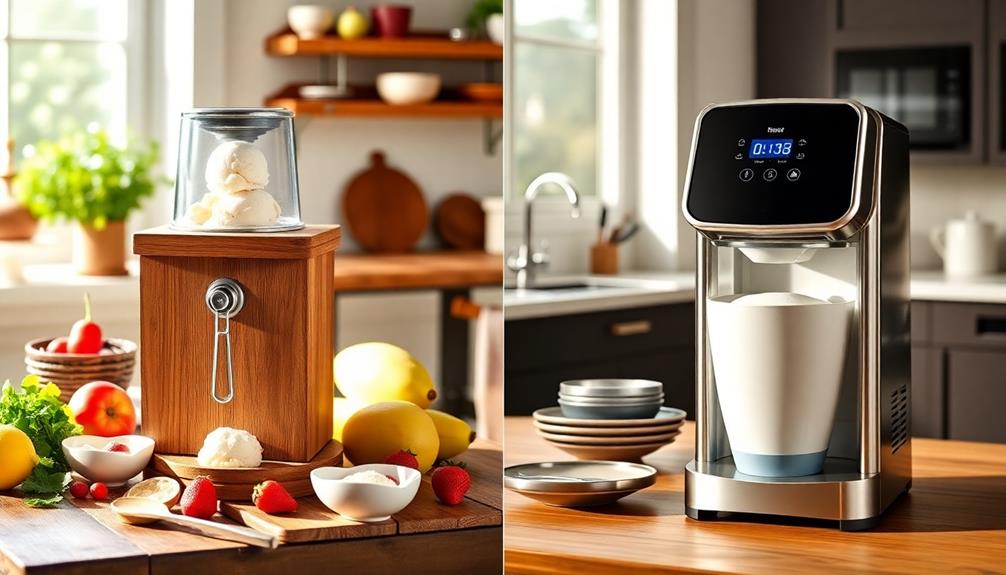When deciding between manual and electric ice cream makers, consider cost, capacity, and maintenance. Manual models are budget-friendly, ideal for beginners, and easy to clean, but they require physical effort and produce smaller batches. Electric options are more expensive but offer greater capacity and efficiency, making them perfect for frequent use and large gatherings. While they save time and effort, electric machines can be noisier and harder to clean. Ultimately, your choice depends on how often you plan to make ice cream and your budget. There's plenty more to explore about these machines and their unique features.
Key Takeaways
- Manual ice cream makers are budget-friendly, making them ideal for beginners and casual users with lower initial investments.
- Electric ice cream makers offer higher capacity and efficiency, producing larger batches suitable for families and frequent entertaining needs.
- Manual machines require more physical effort to churn, while electric models save time and reduce hands-on involvement.
- Maintenance for manual ice cream makers is simpler and typically incurs lower costs compared to the complex mechanisms of electric models.
- The choice between manual and electric machines affects the enjoyment of the ice cream making process, influencing engagement and personal touch.
Cost Considerations

When you're considering the cost of ice cream makers, how much are you willing to invest? If you're on a budget, manual ice cream makers could be your best bet. Their initial cost typically ranges from $20 to $100, making them an accessible choice for those just starting out. You'll find that these models often provide a fun, hands-on experience without breaking the bank.
On the other hand, electric ice cream machines can set you back anywhere from $100 to $500. While they come with advanced technology and features, the higher initial cost mightn't be justifiable for everyone.
If you're looking for something more economical in the long run, manual machines usually incur fewer maintenance and repair costs. This factor can lead to better cost-effectiveness over time.
For commercial use, though, weighing the potential profitability is key. Higher capacity electric machines might justify their hefty price tags through increased efficiency.
Ultimately, budget constraints play a significant role in your decision-making process, and many first-time ice cream makers find that starting with manual models is a smart, cost-effective choice.
Initial Investment
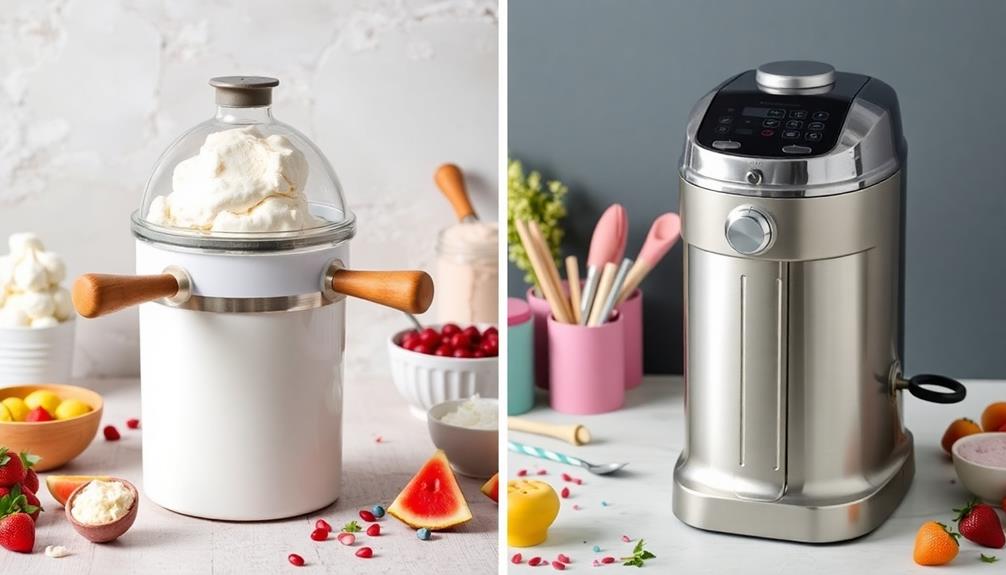
When considering the initial investment for ice cream makers, you'll notice a significant price gap between manual and electric models.
While manual machines can be quite budget-friendly, electric options provide convenience that might be worth the extra cost if you're making ice cream often.
It's important to weigh your budget against your expected usage to make a smart financial decision.
Cost Comparison Analysis
Typically, manual ice cream makers offer a more budget-friendly initial investment, ranging from $20 to $100, making them an attractive option for beginners or casual users.
In a cost comparison analysis, you'll find that this lower price point allows you to dip your toes into homemade ice cream without a hefty financial commitment. If you're just starting out or only plan to make ice cream occasionally, manual machines are a smart choice.
On the other hand, electric ice cream makers typically start around $100 and can soar to $500 or more.
While they require a larger initial investment, they often produce larger quantities in less time. If you frequently entertain guests or run a small business, the speed and efficiency of electric models may justify the higher cost for you.
However, keep in mind that manual ice cream makers involve more physical effort and time.
This aspect might deter some users who prefer the convenience of electric models. Ultimately, your choice will depend on your budget, usage frequency, and how much effort you're willing to put into the ice cream-making process.
Long-Term Financial Impact
Investing in an ice cream maker involves more than just the initial purchase price; it's essential to take into account the long-term financial impact as well.
Manual ice cream makers typically cost between $20 to $100, making them an accessible option for casual users. However, if you're planning to make ice cream frequently, their lower capacity and longer preparation times mightn't be as cost-effective in the long run.
On the other hand, electric ice cream makers usually range from $150 to $300. While they require a higher upfront investment, they justify this cost with advanced features and the ability to produce larger batches more efficiently.
For businesses or avid ice cream lovers, this higher initial expense can pay off through time savings and reduced effort.
When evaluating long-term financial impact, consider maintenance costs too. Manual machines generally have lower repair costs compared to the more complex electric models.
If you plan to use your machine often, balancing initial investment with potential savings and efficiency is key. Ultimately, understanding these factors will help you make an informed decision that aligns with your ice cream-making needs.
Capacity Comparison
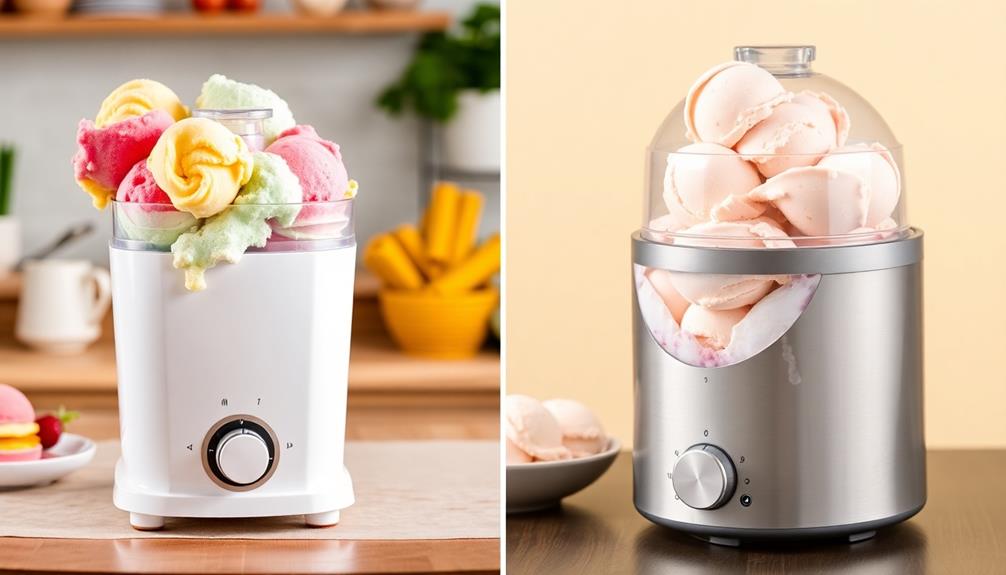
When choosing between manual and electric ice cream makers, think about your batch size limitations and how much ice cream you actually need.
If you're just making a small amount for yourself or a few friends, a manual maker might suffice.
However, for larger production volumes, especially if you're running a small business, an electric model is likely the better choice.
Batch Size Limitations
Choosing between manual and electric ice cream makers often comes down to batch size limitations. If you opt for a manual ice cream maker, you'll typically produce about 1 to 2 quarts per batch. This capacity is perfect for personal use or small gatherings but can become a hassle if you need more ice cream for larger events.
You might find yourself spending extra time making multiple batches, which can be less than ideal when you're in a hurry.
On the flip side, electric ice cream makers shine in this area. Many models can accommodate larger batches, producing 6 quarts or more. This makes them a fantastic choice for families or those who frequently entertain.
While electric models may come with a higher price tag initially, the time and effort you save by not needing to churn out batch after batch can make them more cost-effective in the long run.
Ultimately, it's essential to assess your individual needs and anticipated demand. If you foresee making ice cream in bulk, investing in an electric model is worth considering.
Production Volume Needs
Considering your production volume needs is essential when selecting between manual and electric ice cream makers. If you only plan to whip up ice cream occasionally, a manual ice cream maker might be just what you need, with capacities typically ranging from 1 to 2 quarts. However, if you're gearing up for frequent gatherings or small business endeavors, electric ice cream makers can produce 2 to 6 quarts in a single batch, making them a more suitable choice.
Here's a quick comparison to help you decide:
| Type | Capacity | Best For |
|---|---|---|
| Manual Ice Cream Makers | 1 to 2 quarts | Personal use, occasional gatherings |
| Electric Ice Cream Makers | 2 to 6 quarts | Frequent use, parties, small businesses |
When evaluating your needs, think about how often you'll be making ice cream. Larger electric machines might be worth the investment if your ice cream demand is high. For casual users, a manual model can still deliver delightful treats without the need for a larger capacity. Choose wisely based on your production goals!
Business Suitability Factors
Evaluating capacity is essential for businesses looking to select the right ice cream maker. If you're operating on a small scale, a manual machine can serve you well, as it typically produces 1 to 2 quarts per batch.
However, if you anticipate high customer demand, an electric ice cream maker is your best bet, as it can churn out 2 to 6 quarts or more at a time. This increased capacity allows you to meet customer needs efficiently, especially if you aim to compete with store-bought ice cream.
Investing in an electric model may seem costly initially, but consider the trade-off: higher output can lead to greater revenue. If your sales volume is expected to soar, an electric machine's faster production will save you time and effort, allowing you to focus on other aspects of your business.
Ultimately, the choice between manual and electric ice cream makers boils down to your specific needs. Assess your anticipated sales volume carefully.
The right machine can make a significant difference in your operation, helping you serve more customers and increase your profits.
Additional Features

When it comes to ice cream makers, the additional features can greatly influence your experience in the kitchen. Automatic ice cream makers often come packed with built-in timers and pre-cooling functions, allowing you to enjoy a more hands-off approach. This means you can set it and forget it, achieving consistent results without constant monitoring. However, these advanced features generally come at a higher price.
On the other hand, manual ice cream makers usually lack these conveniences. You'll need to keep an eye on the process, which can be less appealing if you're looking for ease. The choice between simplicity and innovation often depends on your personal preferences.
Here's a quick comparison:
| Feature | Manual Ice Cream Maker | Electric Ice Cream Maker |
|---|---|---|
| Built-in Timer | No | Yes |
| Pre-cooling Function | No | Yes |
| Price Range | Low | High |
Investing in an ice cream maker with additional features can save you time and improve the quality of your homemade treats, especially if you plan to make ice cream frequently.
Maintenance and Longevity

Maintenance and longevity are essential factors to contemplate when choosing between manual and electric ice cream makers. If you prefer a hassle-free experience, manual machines might be the way to go. Their simpler designs make them easier to clean and maintain, often requiring just a quick wash of the components after use.
On the other hand, electric ice cream makers can have more complex mechanisms, which could lead to higher maintenance needs and potential repair costs over time.
When it comes to longevity, manual machines usually outlast their electric counterparts. Their straightforward construction makes them less susceptible to the wear and tear that often comes with motorized parts. If you choose an electric model, be prepared for regular maintenance tasks, such as checking motor function and ensuring proper lubrication, which can be time-consuming.
Ultimately, investing in a manual ice cream maker can lead to lower overall maintenance costs, making it a more cost-effective choice for long-term use. So, consider how much effort you're willing to put into maintenance and how long you want your ice cream maker to last before making your decision.
Pros of Ice Cream Makers
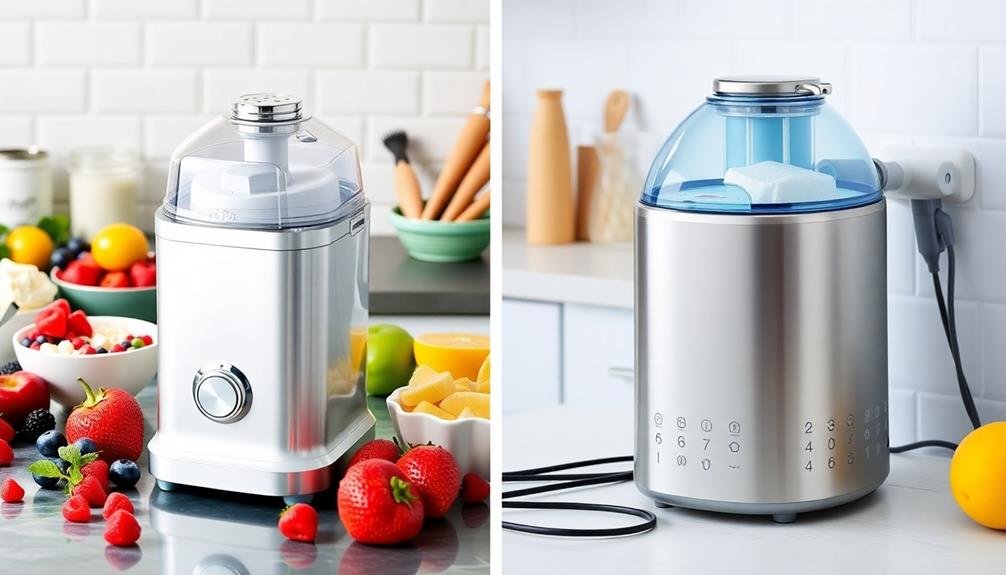
There's no denying that ice cream makers offer a range of advantages, especially for those keen on making their own frozen treats. One significant perk of manual ice cream makers is their affordability. They're budget-friendly, making them perfect for beginners in the world of homemade ice cream.
Their simpler design often means easier cleaning and maintenance, so you won't spend more time scrubbing than enjoying your creations. Manual machines excel at producing smaller batches, giving you the flexibility to experiment with flavors without committing to large quantities. This is particularly appealing if you want to try out new recipes or just whip up a quick treat.
Plus, using a manual ice cream maker can turn the ice cream-making process into a fun family activity. Everyone can get involved, fostering togetherness as you churn away. While the production time may be longer, many users find that the traditional approach enhances the joy of crafting homemade treats.
The satisfaction of creating something delicious with your own hands is hard to beat, making manual ice cream makers a delightful choice for those who value the experience as much as the end product.
Cons of Ice Cream Makers
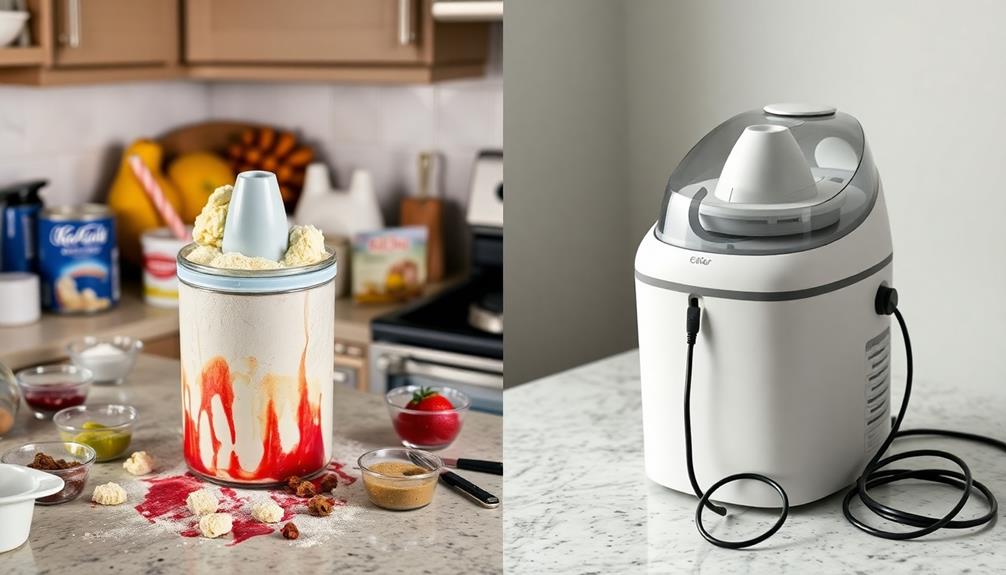
Making ice cream at home can be a delightful experience, but there are certainly some downsides to contemplate.
For one, manual ice cream makers can have a steep learning curve. You'll need to invest physical effort into churning, which can be a turn-off if you prefer convenience.
On the other hand, electric ice cream makers typically come with a higher initial cost. If you only make ice cream occasionally or are on a budget, that cost mightn't feel justifiable.
Cleaning is another hassle. Both types can be cumbersome to clean, but electric models often have multiple components that require thorough maintenance.
Plus, manual ice cream makers usually limit you to small batches, making them less ideal for larger gatherings or commercial use. If you're entertaining a crowd, you might find electric machines more suited to your needs.
Lastly, electric ice cream makers can be noisy while in operation. This noise can disrupt other activities in your kitchen or home environment, which may be an annoyance you hadn't considered.
Weigh these cons carefully before deciding which type suits you best.
Alternatives to Ice Cream Makers
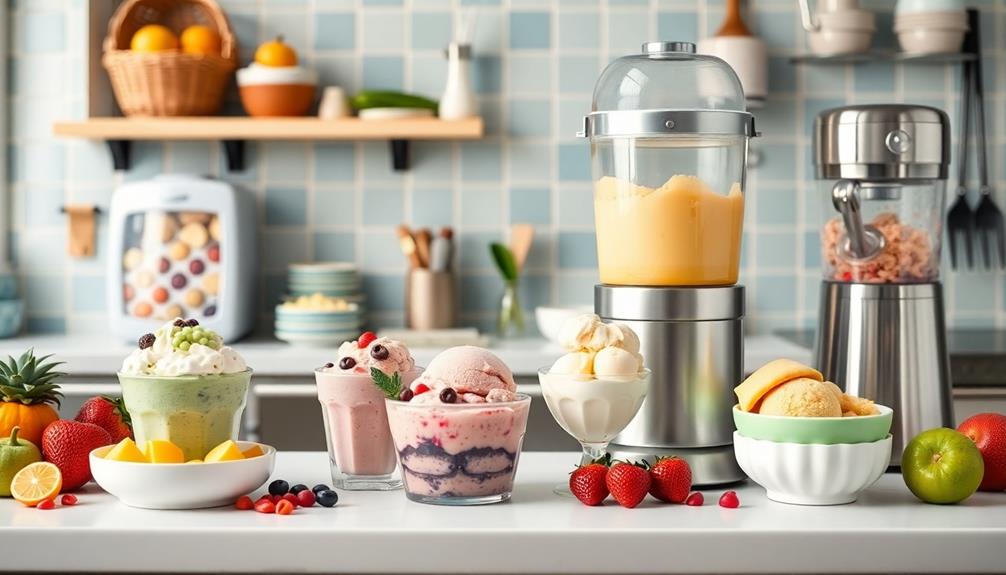
If you're looking for ways to whip up delicious frozen treats without an ice cream maker, you're in luck! There are several fantastic alternatives that let you create ice cream from scratch without the need for specialized equipment. Here are some options to evaluate:
- Food Processors: These can churn ingredients into a creamy mixture, making them a versatile alternative for homemade ice cream.
- Hand Blenders: A low-cost, space-saving option, hand blenders can mix your ingredients until smooth, perfect for quick frozen treats.
- Smoothie Makers: While the texture may differ from traditional ice cream, smoothie makers can whip up similar frozen desserts with ease.
Using these alternatives to ice cream makers not only simplifies the process but also allows you to experiment with flavors and textures. You can create quick and healthy treats using frozen fruits or yogurt in a food processor.
Testing various methods will help you determine if a dedicated ice cream maker is worth the investment based on your personal preferences and how often you make ice cream. Enjoy exploring these creative options!
Ice Cream Making Experience
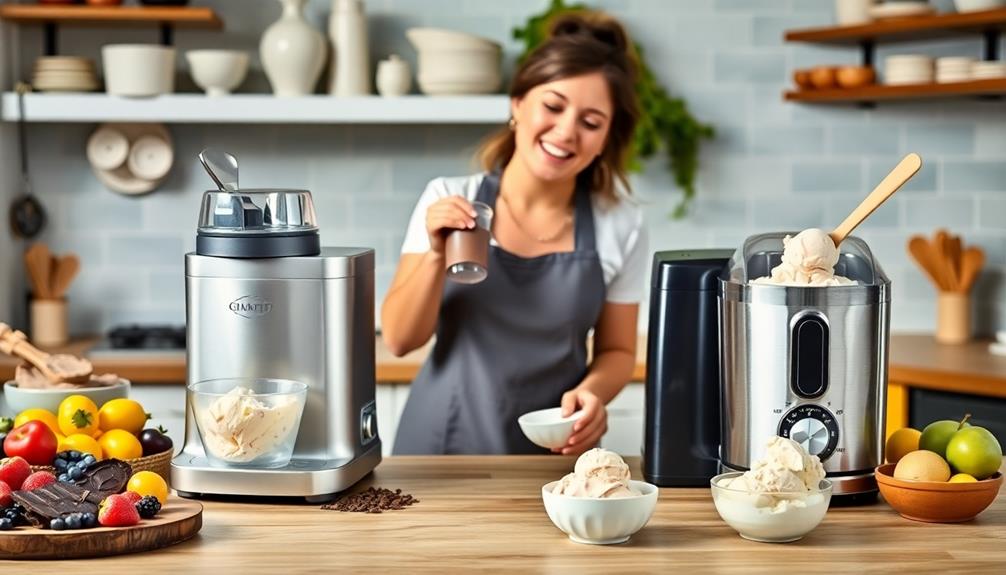
When you plunge into the world of ice cream making, the experience can be as enjoyable as the final product. Choosing between manual and electric ice cream makers can greatly impact how you engage with this delicious homemade treat.
| Aspect | Manual Ice Cream Makers | Electric Ice Cream Makers |
|---|---|---|
| Time and Effort | Requires more physical effort, making it engaging | Faster freezing times, less hands-on involvement |
| Control over Consistency | Adjust mixing speed and duration easily | Consistency is less adjustable |
| Personal Touch | Allows for flavor experimentation and texture adjustment | Quick results, less personal involvement |
If you love hands-on activities, a manual machine offers a rewarding experience as you churn out your ice cream. Over time, you'll develop a deeper appreciation for the craft, enhancing your skill in creating delicious homemade flavors. On the other hand, if you prefer to multitask or relax while your ice cream freezes, an electric maker may suit you better. Ultimately, the choice depends on your desired experience and how you want to enjoy the art of ice cream making.
Frequently Asked Questions
Is It Better to Make Ice Cream With a Machine?
Using a machine to make ice cream definitely simplifies the process. You'll enjoy consistent results, quicker freezing times, and the ability to experiment with flavors, making your homemade treats even more delightful and satisfying.
What to Consider When Buying an Ice Cream Machine?
Before you buy an ice cream machine, think about your budget, how much ice cream you need, and the features you desire. It's essential to take into account maintenance too—some options might surprise you!
How Long Does It Take to Churn Ice Cream in an Electric Ice Cream Maker?
It usually takes you about 20 to 30 minutes to churn ice cream in an electric ice cream maker. With some high-end models, you might even enjoy a creamy treat in just 15 minutes!
Is It Worth Buying an Ice Cream Maker?
If you crave creamy delights, enjoy hosting, and want to experiment with flavors, buying an ice cream maker's worth it. You'll create unique treats, impress friends, and savor every scoop of homemade goodness.
Conclusion
In the world of ice cream makers, choosing between manual and electric can feel like a sweet dilemma. While manual models charm you with their simplicity and lower cost, electric ones offer convenience and speed that's hard to resist. You'll savor the hands-on experience of cranking out your own treat, yet you might also delight in the effortless churn of an electric machine. Ultimately, it's about what suits your taste and lifestyle—both paths lead to delicious rewards.
